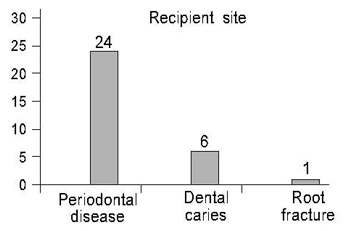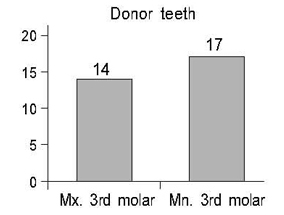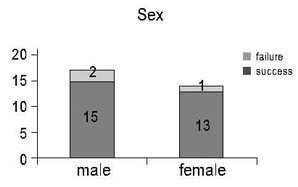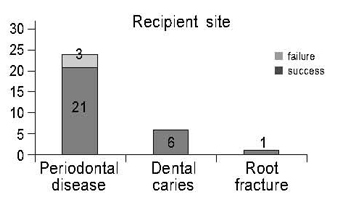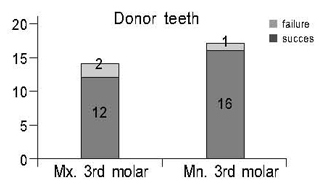J Korean Acad Periodontol.
2009 Dec;39(4):431-435.
Long-term evaluation of autotransplanted third molars
- Affiliations
-
- 1Department of Periodontology, School of Dentistry, Kyungpook National University, Daegu, Korea. leejm@knu.ac.kr
Abstract
- PURPOSE
The purpose of this study is to evaluate the long term clinical and radiographic outcome and stability after transplantation of third molar with complete root formation. METHODS: The subjects were 31 teeth (male 17, female 14, aged 22-55, average 39.9 yr old) of 31 patients who visited the department of periodontics and passed more than two years after autotransplantation procedure and still under regular check up. Modified success criteria of Chamberlin and Goerig was applied to determine the success of autotransplantation. RESULTS: Three out of 31 teeth failed and resulted 90.3% of success rate. When compared according to sex, 15 out of 17 teeth had succeeded in male, 13 out of 14 succeeded in female. When compared the success rate according to cause of extraction, tooth loss due to caries and root fracture had all succeeded but 3 out of 24 had failed in tooth loss due to periodontal disease. When compared according to donor teeth, 12 out of 14 maxillary third molars and 16 out of 17 mandibular third molars had succeeded. CONCLUSIONS: In long term evaluation over two years, if appropriate surgical procedure and proper case selection is made, autotransplantation of the third molar with complete root formation can be the alternative choice that substitutes prosthetic or implant treatment and it is a functionally acceptable procedure.
Keyword
MeSH Terms
Figure
Reference
-
1. Slagsvold O, Bjercke B. Indications for autotransplantation in cases of missing premolars. Am J Orthod. 1978. 74:241–257.
Article2. Holland DJ. The surgical positioning of unerupted, impacted teeth. Oral Surg Oral Med Oral Pathol. 1956. 9:130–140.3. Miller HM. Transplantation of teeth. NY State Dent J. 1951. 17:382–386.4. Mendes RA, Rocha G. Mandibular third molar autotransplantation-literature review with clinical cases. J Can Dent Assoc. 2004. 70:761–766.5. Waikakul , Kasetsuwan J, Punwutikorn J. Response of autotransplanted teeth to electric pulp testing. Oral Surg Oral Med Oral Pathol Oral Radiol Endod. 2002. 94:249–255.
Article6. Hammarströme L, Blomloef L, Lindskog S. Dynamics of dentoalveolar ankylosis and associated root resorption. Endod Dent Traumatol. 1989. 5:163–175.
Article7. Lee SJ, Jung IY, Lee CY, Choi SY, Kum KY. Clinical application of computer-aided rapid phototyping for tooth transplantation. Dent Traumatol. 2001. 17:114–119.
Article8. Andreasen JO, Paulsen HU, Yu Z, Schwartz O. A long-term study of 370 autotransplanted premolars. part III. Periodontal healing subsequent to transplantation. Eur J Orthod. 1990. 12:25–37.
Article9. Andreasen JO. Effect of extra-alveolar period and storage media upon periodontal and pulpal healing after replantation of mature permanent incisors in monkeys. Int J Oral Surg. 1981. 10:43–53.
Article10. Pogrel MA. Evaluation of over 400 autogenous tooth transplants. J Oral Maxillofac Surg. 1987. 45:205–211.
Article11. Andreasen JO, Andreasen FM. Textbook and color altas of traumatic injuries to the teeth. 1994. Copenhagen: Munksgaard;671–690.12. Chamberlin JH, Goerig AC. Rationale for treatment and management of avulsed teeth. J Am Dent Assoc. 1980. 101:471–475.
Article13. Smith DE, Zarb GA. Criteria for success of osseointegrated endosseous implants. J Prosthet Dent. 1989. 62:567–572.
Article14. Cohen AS, Shen TC, Pogrel MA. Transplanting teeth successfully; autografts and allografts that works. J Am Dent Assoc. 1995. 126:181–184.15. Lundberg T, Isaksson S. A clinical follow up study of 278 autotransplanted teeth. Br J Oral Maxillofac Surg. 1996. 34:181–185.16. Nethander G. Oral restoration with fixed partial dentures on transplanted abutment teeth. Int J Prosthodont. 1995. 8:517–526.17. Clokie CM, Yau DM, Chanol L. Autogenous tooth transplantation: an alternative to dental implant placement. J Can Dent Assoc. 2001. 67:92–96.18. Hupp JG, Mesaros SV, Aukhil I, Trope M. Periodontal ligament vitality and histologic healing of teeth stored for extended periods before transplantation. Endod Dent Traumato. 1989. 14:79–83.
Article19. Kallu R, Vinckier F, Politis C, Mwalili S, Willems G. Tooth transplantations: a descriptive retrospective study. Int J Oral Maxillofac Surgery. 2005. 34:745–755.
Article20. Kim E, Jung JY, Cha IH, Kum KY, Lee SJ. Evaluation of the prognosis and causes of failure in 182 cases of autogenous tooth transplantation. Oral Surg Oral Med Oral Pathol Oral Radiol Endod. 2005. 100:112–119.
Article
- Full Text Links
- Actions
-
Cited
- CITED
-
- Close
- Share
- Similar articles
-
- Replantation of autotransplanted mature third molar in anterior open bite patient: case report
- Evaluation of Autotransplantation
- Korean Elderly Long-term Care Insurance System and Long-term Care Hospital
- Third molar changes following lower second molar extractions
- Long-term survival of retained deciduous mandibular second molars and maxillary canine incorporated into final occlusion


